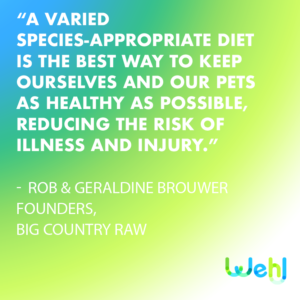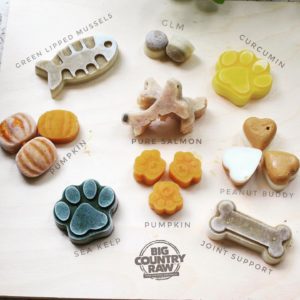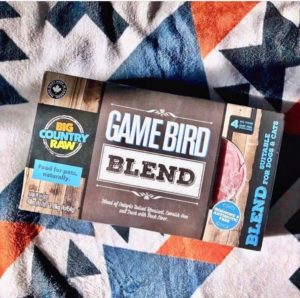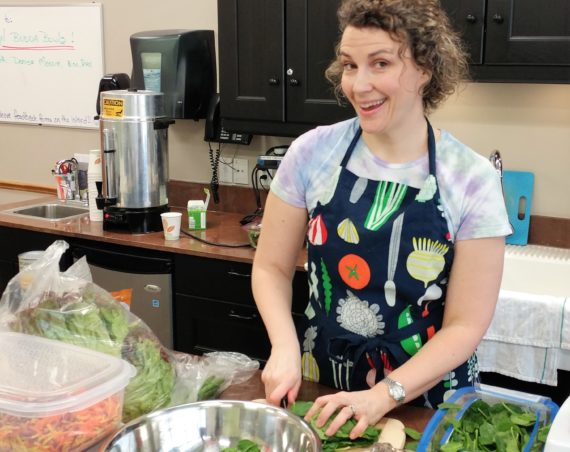Have you ever given your pet raw pet food? What we eat plays such a big role in our wellness, and the same goes for the wellness of our pets. Not only does eating better help us feel better, it can help our pets feel better too! Geraldine Brouwer was running Big Country Kennels and had just made the switch to feeding her dogs a raw diet. After seeing the positive effects on her dogs, she decided to start Big Country Raw. At the time she didn’t think she, along with her husband Rob, would be running a raw dog food company with over 80 employees. Just a few years later, their product is now sold in 750 retailers across Canada.
We wanted to chat with Geraldine and Rob about the health benefits of feeding your pet raw food, what you should look for in pet food, and how you can transition your own pet (not only dogs) to a raw food diet.
 WEHL: Tell us a little about yourself and why you became interested in wellness and starting Big Country Raw?
WEHL: Tell us a little about yourself and why you became interested in wellness and starting Big Country Raw?
R&GB: We are proud to call Ontario our home and contribute to the Canadian pet food industry. Our family, faith, and the hardworking team we get to work with every day is what makes us proud owners of Big Country Raw. We started making raw pet food for our kennel, Big Country Kennels, with the desire to feed our dogs and growing puppies a nutritious raw food diet. We opened our store in 2012 with a commitment to producing high quality, affordable and safe raw pet food. We are thankful for the many loyal customers that have chosen to support us and our brand.
WEHL: What is your philosophy on wellness? human and/or pet-related 😉
R&GB: Food can be a medicine or a poison. Health and wellness begin with the food we eat. A varied species-appropriate diet is the best way to keep ourselves and our pets as healthy as possible, reducing the risk of illness and injury.

WEHL: What is raw pet food?
R&GB: Raw pet food is species appropriate for our carnivore pets. It is uncooked, unpasteurized and otherwise unprocessed, a whole food approach to a healthy diet.
WEHL: What are some of the health benefits of feeding your pet raw food?
R&GB: A raw food diet provides a variety of benefits including:
- No doggie odour
- Healthier skin and coat and less shedding
- No more tear stains
- No more stinky paws and ears or breath
- No more expensive vet visits
- Increased vitality

WEHL: Can you feed raw food to cats and dogs? Any other home-friendly animals?
R&GB: A fresh, raw food diet is species-appropriate for any carnivore – dogs, cats, ferrets…
WEHL: What are some tips on transitioning from kibble to raw food?
R&GB:
- Fast your dog for 12-24 hours (not advised for puppies 8-24 weeks)
- Start with a poultry protein such as chicken, turkey, duck or rabbit. These proteins are often easier to digest which will result in a quicker transition.
- Serve first few raw meals at room temperature. Food that is icy cold from the refrigerator can cause your dog to regurgitate. Waiting for food to be warm also enhances food aromas.
- Offer 1/2 the recommended serving. Wait 10-20 minutes and offer the remaining portion. This prevents over-eager eaters from eating too quickly and regurgitating the food.
WEHL: What should people look for when purchasing raw pet food?
R&GB: A quality raw food diet should be human grade, sourced from CFIA inspected facilities, hormone, and antibiotic-free.
WEHL: What can a pet owner expect once they’ve made the switch to raw food?
R&GB: You can expect a pet that loves their new diet – perhaps rejoicing at mealtimes. Some dogs take some time to get past the feeling of having been put on a “diet” – kibble expands in the stomach when it hits the moisture and raw does not so sometimes our pets will feel hungry even though their nutritional needs are being met.
Usually, the very first stool after a raw meal will be firm and formed – many kibble feeders have never seen this before.
 WEHL: What are some of the challenges of feeding your pet raw food?
WEHL: What are some of the challenges of feeding your pet raw food?
R&GB:
- The perception that it’s “complicated” – a proper raw diet isn’t difficult to achieve.
- A picky dog – modern dogs are often over-fed which leads to fussiness.
WEHL: There are a lot of different protein options – how do you find out which is the right one for your dog? How often do you switch up their main protein?
R&GB: They’re all “the right one” for your dog. If you’re not dealing with a protein intolerance or dietary allergies, your best bet is to offer as much variety as you can – we suggest 5 or more protein options monthly. The more variety, the better. This keeps our dogs interested in their food and offers proper nutrition
WEHL: A lot of people give their pets cooked or smoked bones. Do you recommend this? If you don’t, what kind of bones do you recommend instead?
R&GB: Smoked or cooked bones are NOT safe to feed to our pets. Raw bones are the only bones our pets should be eating. Bone chewing sessions should always be supervised. If your dog has a tendency to swallow things whole, raw bones are not a great choice.
WEHL: You have a raw fermented goat milk product. Why is goat milk good for pets and how does it differ from cow’s milk?
R&GB: Goat milk contains different, more digestible proteins than cow milk. As a result, it is less likely to cause digestive upset. Our raw fermented goat milk is also fortified with 2 probiotic cultures for supreme gut health.
WEHL: Tell us a little about where you source your ingredients and where you make your products.
R&GB: Our products are sourced as locally as possible, always from CFIA inspected facilities.

WEHL: Do you have any other tips to help us take a preventative approach and keep our dogs healthy?
R&GB: A raw diet can and must always be adjusted for your individual dog’s needs. For example, some dog breeds are predisposed to urinary stones and should be fed accordingly. Also, keeping our pets at a healthy weight is the number one thing we can do to maintain health.
Connect with Rob & Geraldine Brouwer and Big Country Raw:
- Web: www.bigcountryraw.ca
- Email: [email protected]
- Phone: 905-957-2717
We invite you to join our all-in-one healthy lifestyle app at Wehl.com!




4 Comments
Renato saluri
I always hear different opinions from people or from vets.
I have a 1 year old female small dog (15 pounds)
I’ve been feeding her big country raw for 6 months.
I switch her food often.
Once the 1 pound pouch is finished 3-4 days I switch again to something else .
I’ve rotated between kangaroo, lamb dinners, duck
Is this switch to drastic?
She loves all these foods equally
I also add 2 table spoons of the fruit and vegetables blend at every feeding ( feeding 2 times a day)
Should I stick to one type or keep rotating?
Kenneth
Hi, thanks for reading our interview with Big Country Raw! Thanks also for your comment! I’d suggest you reach out directly to Big Country Raw at [email protected] and hopefully they can provide some answers for you 🙂
Peter and Ann Barbour
I am confused about which products are complete and you don’t have to add fruit or veggies. I have been feeding this for a couple of years and thought they were all complete so please explain!
Kenneth
Thanks for reading our interview with Big Country Raw! Unfortunately we do not know the answer to your question, but would recommend you contact them directly at [email protected] and they can probably help you out! 🙂